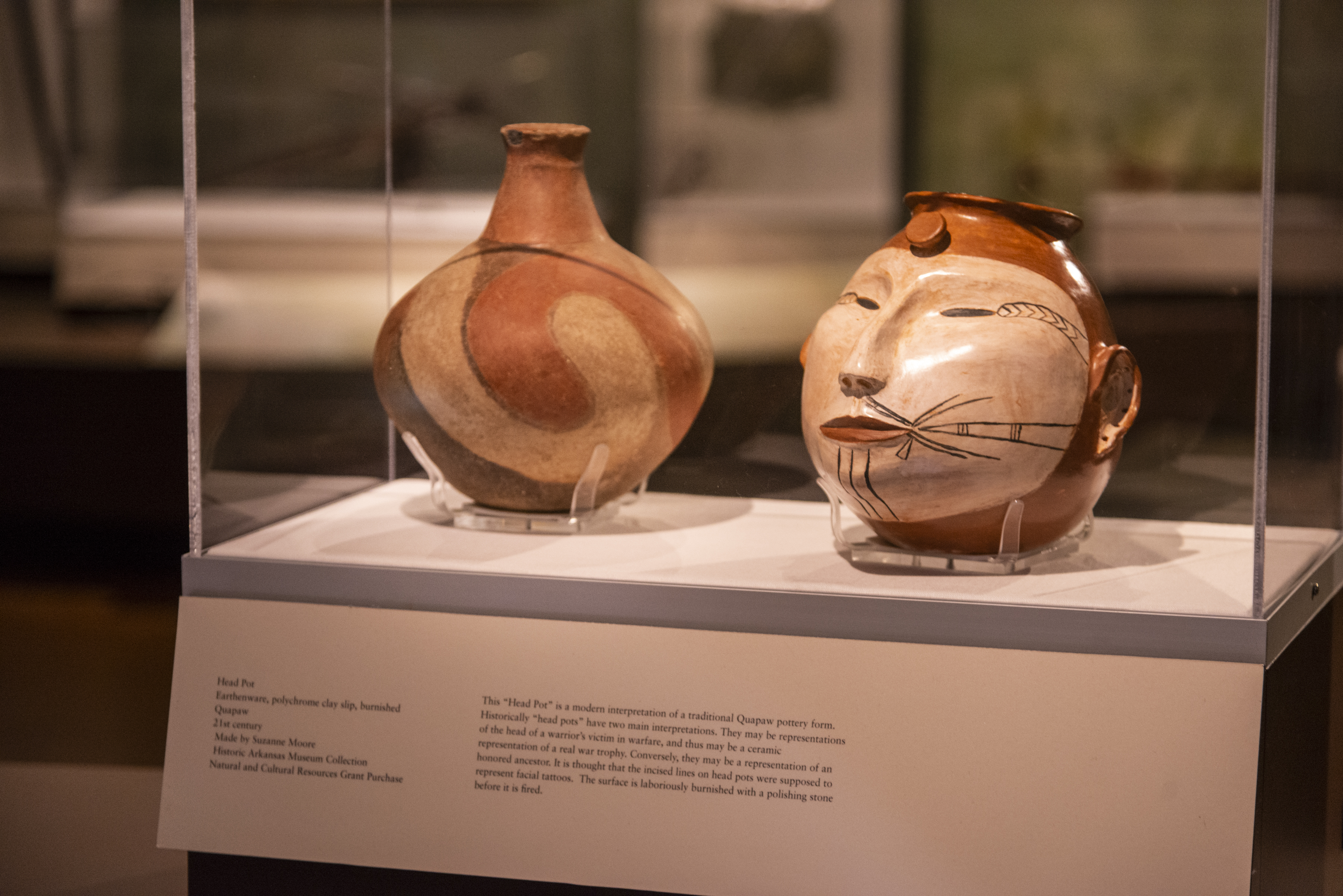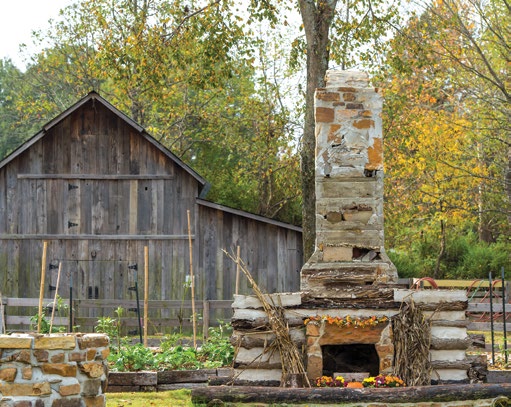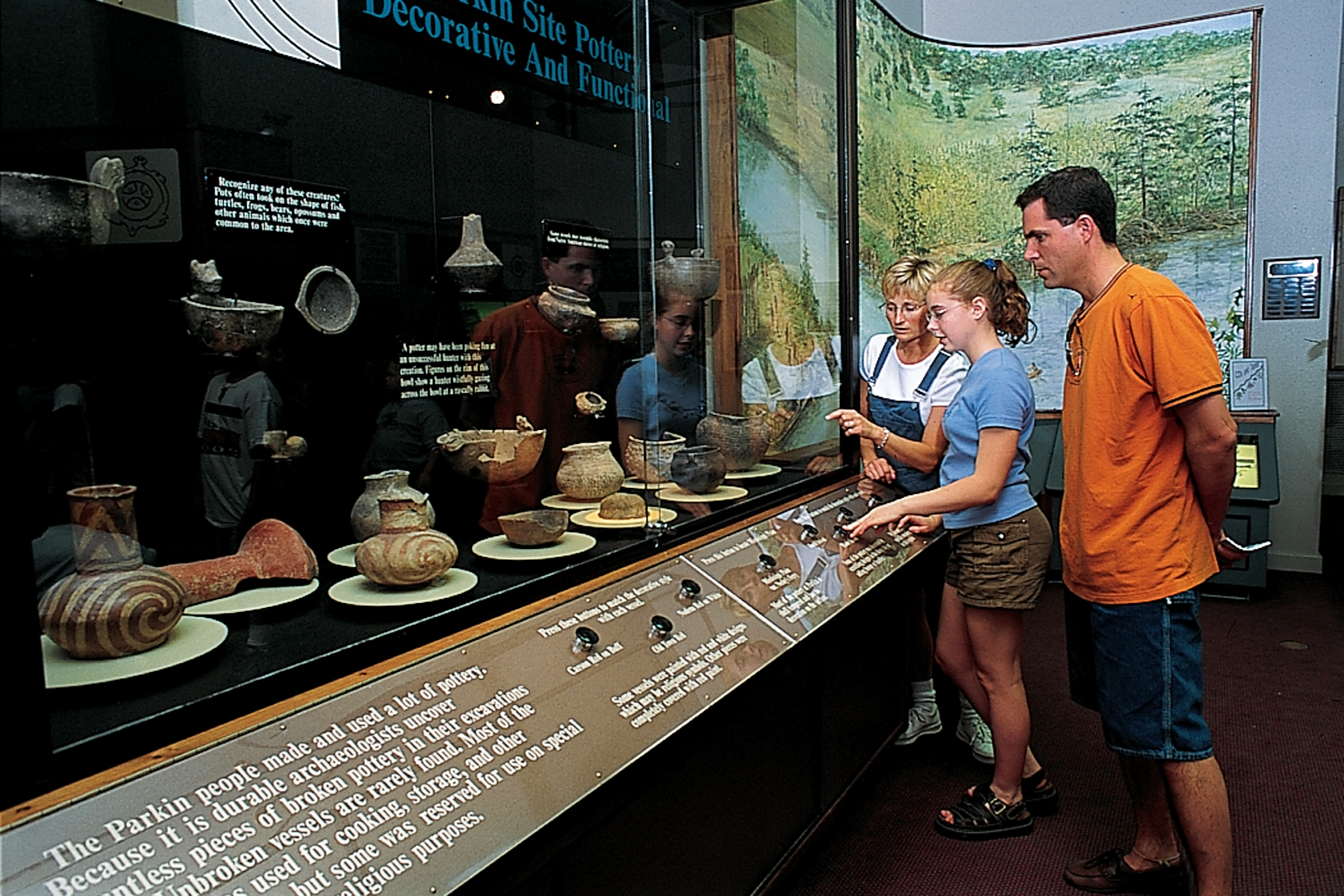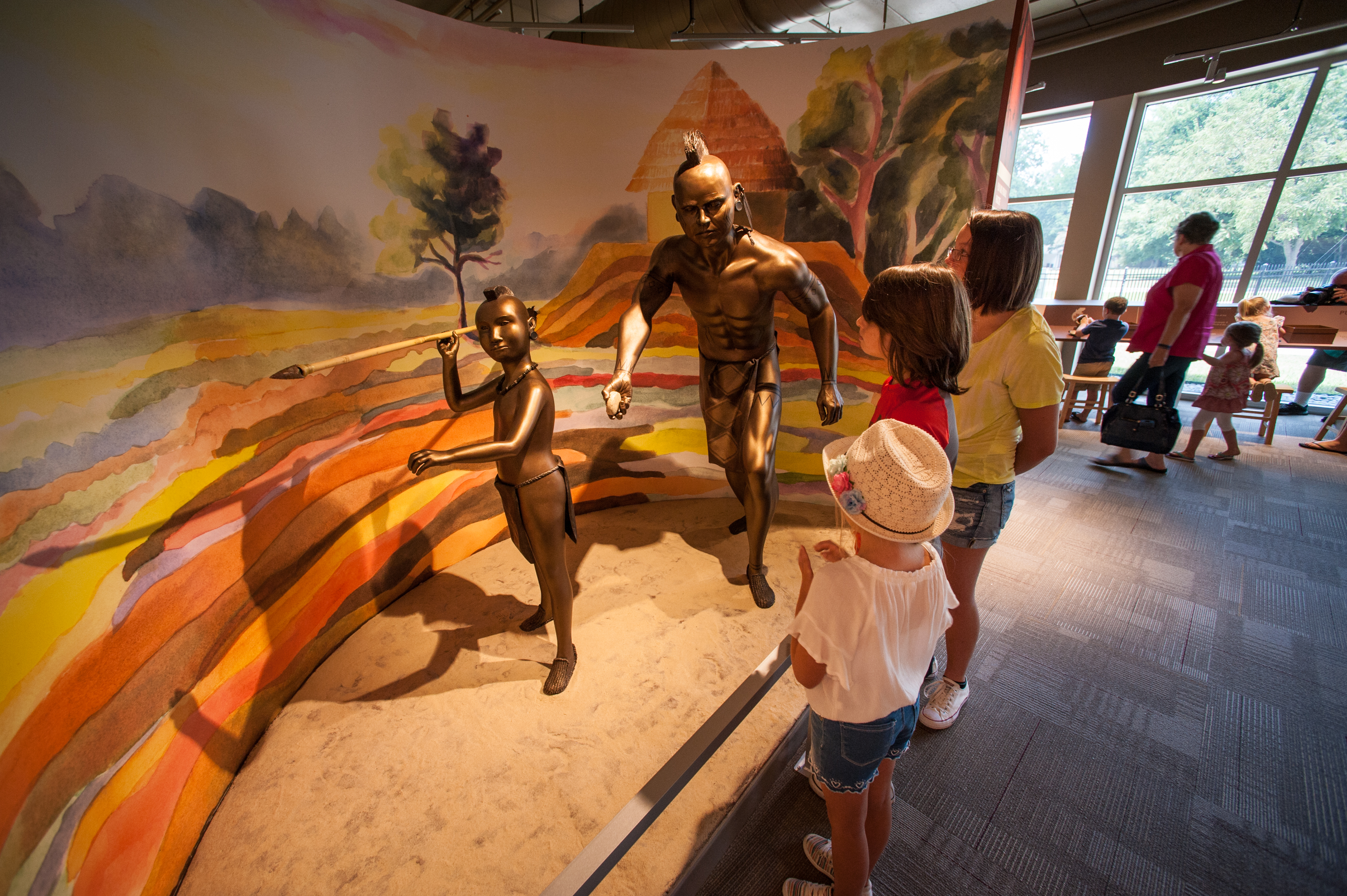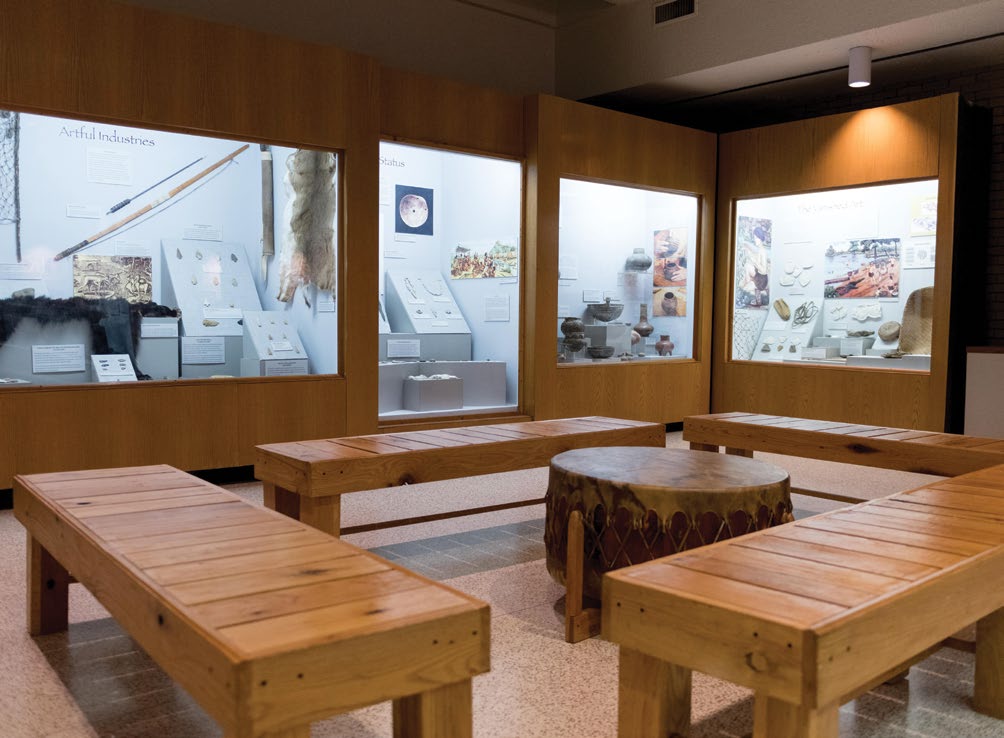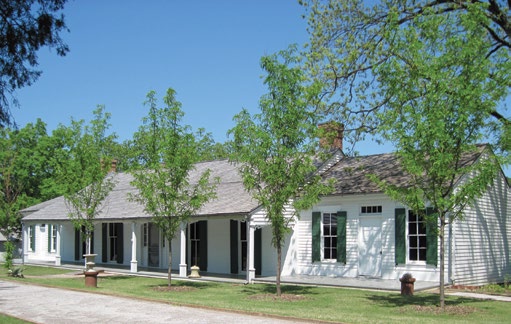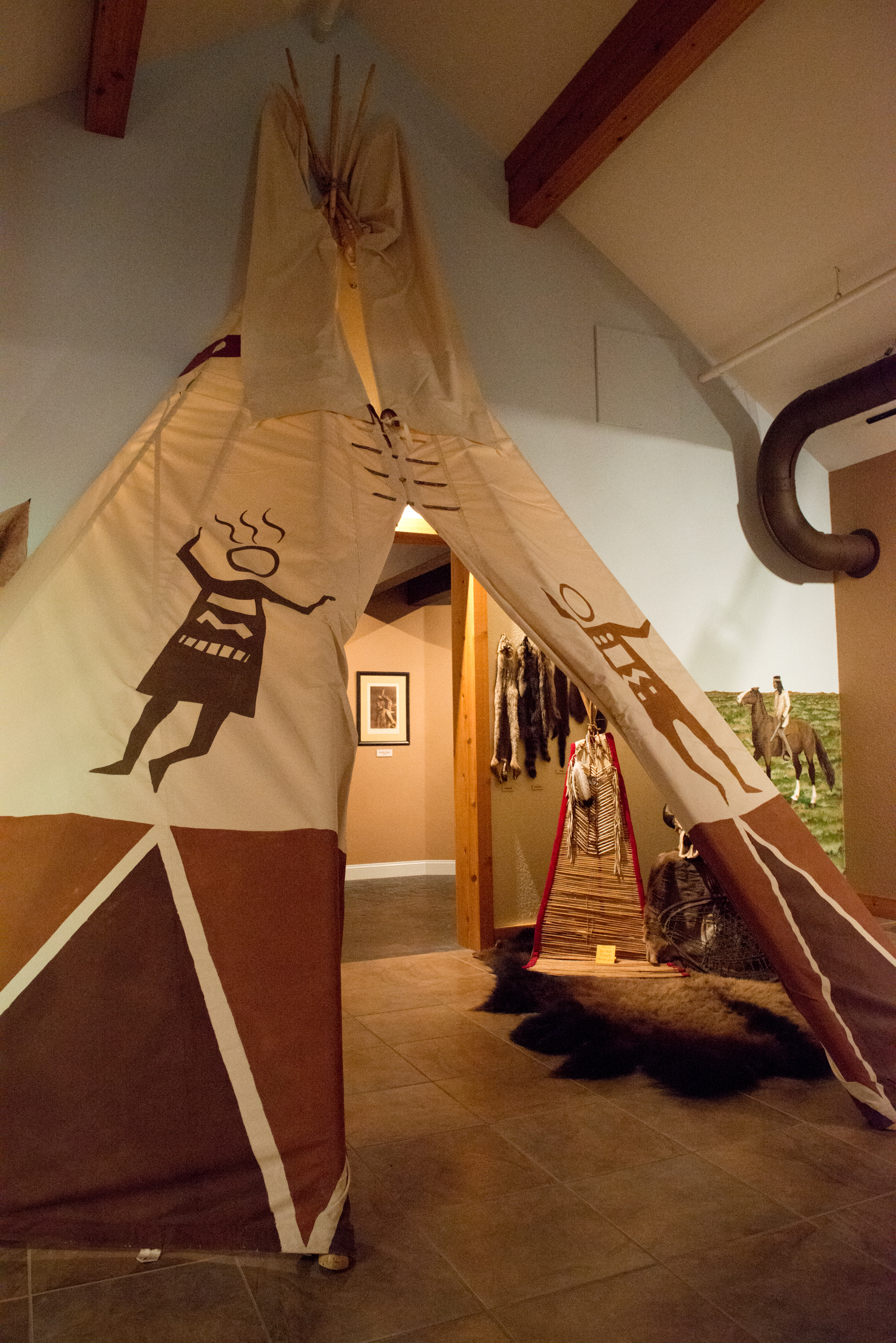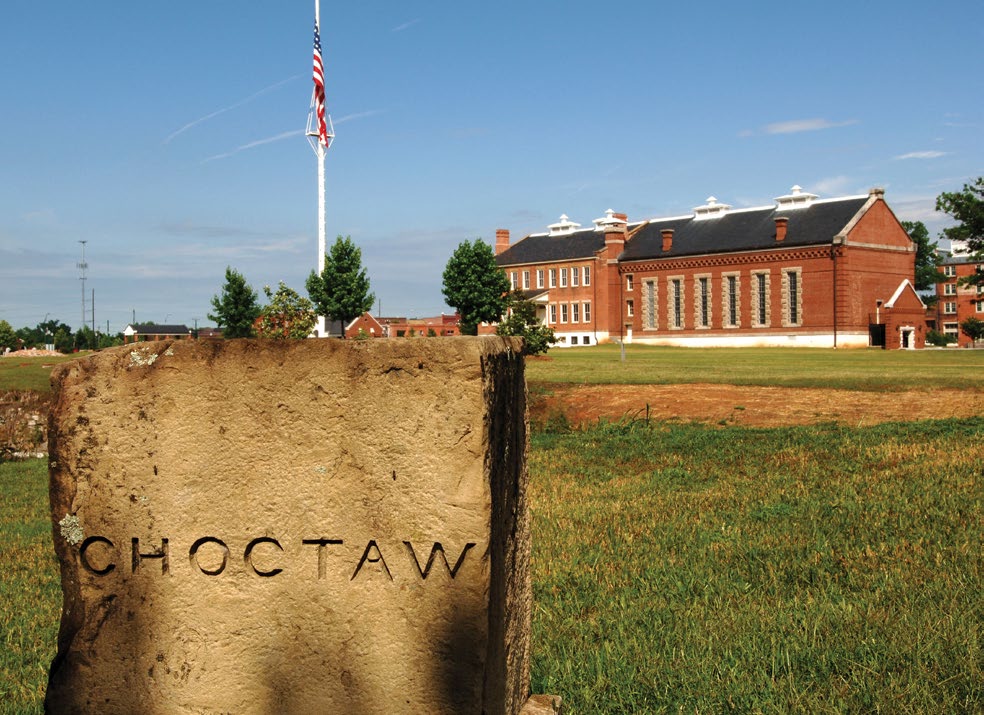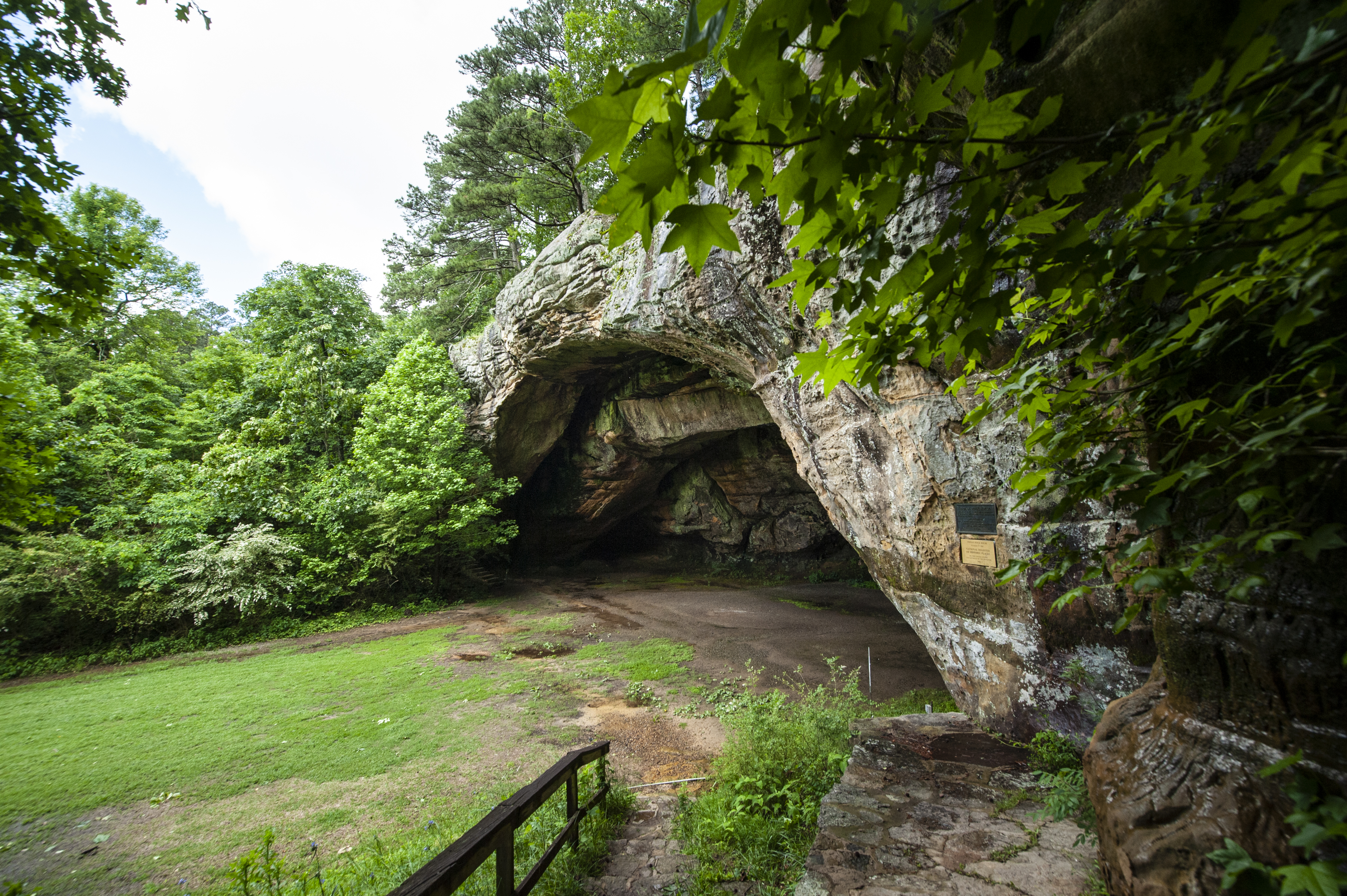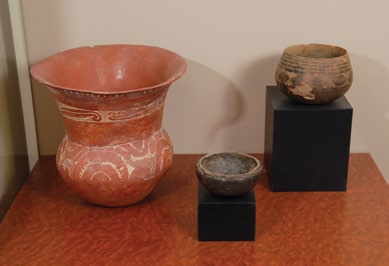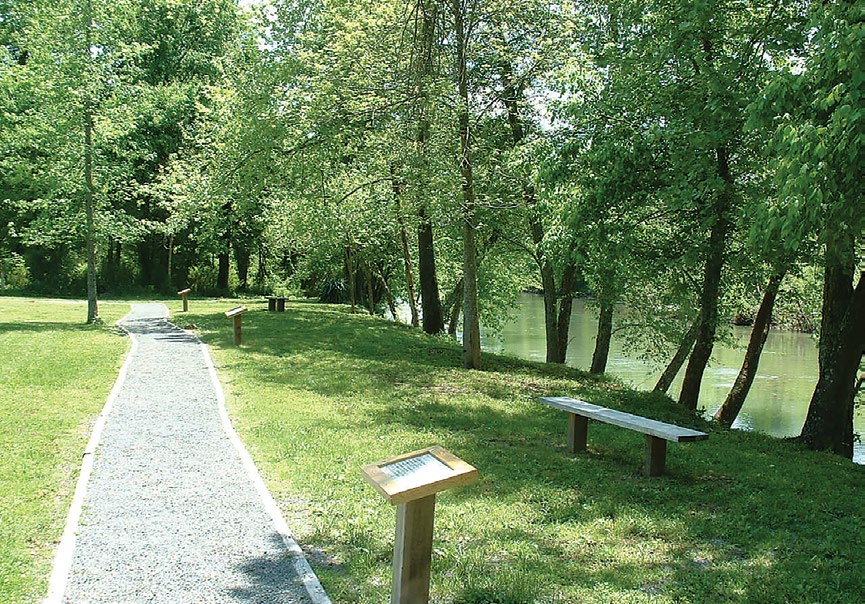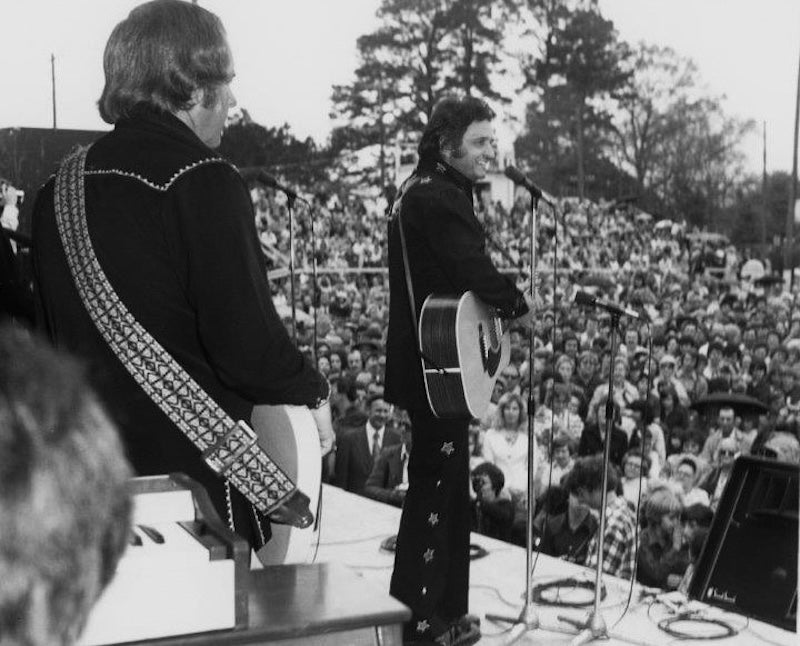Native American Heritage in Arkansas: Native American Heritage Sites
Sequoyah National Research Center
Located on the University of Arkansas at Little Rock campus, the center is the largest assemblage of Native American expression in the world, including tribal newspapers, poetry, history books and art. The mission of the program is to acquire and preserve the writings and ideas of Native North Americans. In addition to archived materials for research, there’s an adjacent art gallery with rotating exhibits. Not far from the center is Trail of Tears Park, with commemorative plaques explaining the site’s relevance for the removal of Choctaw and Chickasaw, and planted with native grasses and plants they may have seen on the trail.
Plum Bayou Mounds Archeological State Park
The 185-acre National Historic Landmark, cooperatively managed by Arkansas State Parks and the Arkansas Archeological Survey, preserves the site of a mound-building culture known as the Plum Bayou people, who inhabited the surrounding area and used the site for ceremonies and civic events during AD 650 to 1050. Three mounds remain where 18 once stood, in alignment with solstice and equinox, and are surrounded by an earthen embankment 8 to 10 feet in height, a portion of which is still visible today. Two barrier-free trails with interpretive panels wind through the impressive grounds, including a boardwalk over Mound Pond. An exciting new feature of the park is the Plum Bayou Garden, a living demonstration of the plants and raw materials the ancient culture drew upon for their sustenance. Extensive exhibits inside the visitor center provide further history of this fascinating glimpse into the distant past. Plum Bayou Mounds Archeological State Park was formerly named Toltec Mounds Archeological State Park.
Historic Arkansas Museum
A trove of Arkansas’s historical artifacts and information concentrating on the pre-Civil War era, Historic Arkansas Museum has a permanent exhibit devoted to Native American life in The Natural State called “We Walk in Two Worlds: The Caddo, Osage & Quapaw in Arkansas.” The exhibition contains 158 objects, such as pottery, clothing and weapons, but most important is the dominant presence of the Native American voice, from each of Arkansas’s three prominent tribes, who were extensively consulted and interviewed.
The Gravestone and Memorial of Quatie Ross
Much myth and mystery surround the life of Quatie Ross, the wife of Cherokee chief John Ross. According to reports, she died near Little Rock on February 1, 1839, during the forced march of the Trail of Tears, reputedly freezing to death when she gave her covering to warm a child. Her original marker was thought lost until discovered in Little Rock’s historic Mount Holly Cemetery. The original stone is preserved now in Historic Arkansas Museum, and a replica is in Mount Holly, along with a memorial, where visitors often leave tokens in the American Indian tradition.
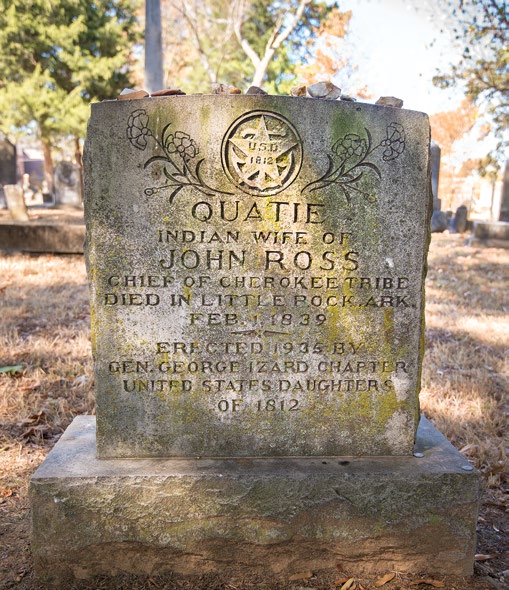
Petit Jean State Park Rock House Cave
Not a true cave but a large rock shelter, the walls at Petit Jean State Park's Rock House Cave contain more than 100 spectacular examples of prehistoric rock art by Native Americans, accessed by an easy .25-mile trail. The site was occupied off and on from the late Paleoindian period (8000 BC) to the Mississippi era (AD 900-1600), but the exact date of the art has not been determined.

Cadron Settlement Park
Cadron Settlement Park is on the National Register of Historic Places and played a significant role in the Trail of Tears for Native Americans. In 1834, a group of Cherokees emigrating to Oklahoma were felled by a cholera epidemic when stopped here. The Faulkner County Historical Society conducted a cemetery census in 1991 and identified almost 50 Native American graves and more that were unidentifiable.
Reed's Bridge Battlefield Heritage Park
This park encompasses a battlefield of the 1863 Little Rock campaign during the Civil War, but the military highway through it was also a route of the Trail of Tears. Narrative historical markers highlighting the site’s interest for Native Americans include information about the crossing by the John Bell detachment of some 660 Cherokees in December of 1838.
Parkin Archeological State Park
This significant historical site is believed by many scholars to be the Native American village of Casqui, mentioned in reports from members of the de Soto expedition in the summer of 1541. Over the 17 acres along the St. Francis River, a large platform mound has been preserved, and visitors can walk a three-quarter-mile trail with interpretive panels and imagine what life was like when the village was active from AD 1000 to 1600. A station for the Arkansas Archeological Survey allows visitors to see and experience how archeologists conduct research and work.
Hampson Archeological Museum State Park
This park exhibits a nationally renowned collection from the Nodena site, a 15-acre palisaded village that once thrived near the Mississippi River in what is today Mississippi County. The home of a farming-based civilization that lived there from AD 1400 to 1650, the area has yielded many remarkable archeological finds, including colorfully painted pottery and vessels, and stone tools. The park is located on the north edge of Wilson on U.S. Highway 61 and Park Avenue.
Arkansas State University Museum
Among the exhibits in Arkansas State University Museum is “Portals of the Soul: Ancient Peoples of Northeast Arkansas” in the Native American Gallery, which opened in 2009. It presents the story of Arkansas’s first civilization – the Native American artisans who poured out their creativity and honored the spirits with powerful and beautiful designs in artifacts of pottery, shell, copper and stone.
Arkansas Post National Memorial
Henri de Tonti, a French fur trapper and trader, established this post in 1686 at the Quapaw village of Osotouy, near the confluence of the Arkansas and Mississippi rivers, to do business with the tribe. The thriving village became a part of the United States with the Louisiana Purchase in 1803 and was the first territorial capital of Arkansas. The Menard-Hodges site nearby, under the auspices of the memorial, holds Native American mounds and was listed as a National Historic Landmark in 1989. The Quapaw tribe is cooperating with the National Parks Service on preserving and interpreting the site.
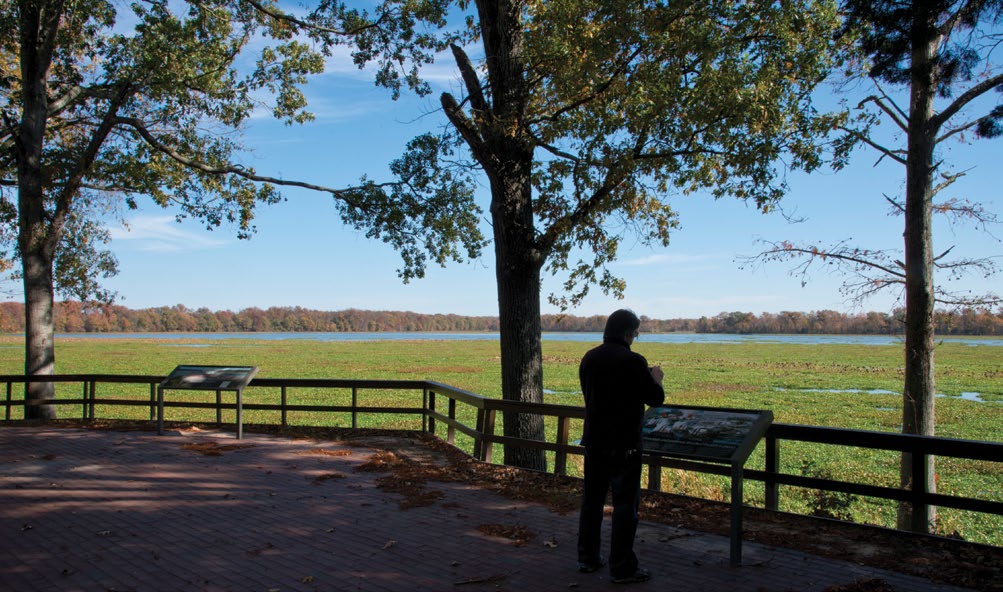
Drennen-Scott House
John Drennen, one of the founders of the town of Van Buren, built this house overlooking the Arkansas River in 1838, and it has been converted to a history museum under the leadership of the University of Arkansas at Fort Smith. Important to those interested in Native American history is Drennen’s role as an Indian agent on the frontier, including his oversight of the eligibility process for settlement payments for the Cherokees who had been relocated to the Indian Territory in what is now Oklahoma.
Museum of Native American History
Take a 14,000-year journey through Arkansas’s and America’s past. Exhibits follow chronological order, starting with the first peoples through the 20th century. Artifacts, tools, beautiful crafts and art abound: arrowheads, pottery, clothing and blankets give a rich history of Native American life over the centuries. The Sweetwater Biface is a particularly famous work of Caddoan stonework. Audio wands are available for self-guided tours.
Ridge House
This house contains the log walls of the original structure from the 1830s. In 1840, it was sold to Sarah Ridge, the widow of John Ridge, a leader of the Cherokees who was instrumental in promoting and signing the Treaty of New Echota in 1835, which it was hoped would encourage Cherokees to accept a voluntary move to Indian Territory. Most Cherokees rejected the treaty, and the government began forced removal, leading to the Trail of Tears. John Ridge was murdered in 1839, and his wife moved to Fayetteville, where she lived until her death in 1856. Now owned by the Washington County Historical Society, the house is open by appointment.
University of Arkansas Museum Collections
The University of Arkansas Museum Collection houses more than 7,000 catalogued Native American whole pottery vessels – the largest single collection of late prehistoric and protohistoric period whole pottery vessels from Arkansas. In addition to the whole pottery vessels, the collections include hundreds of thousands of artifacts that come from all parts of Arkansas, and that range in age from the oldest Native-made tools more than 10,000 years in age to historic period objects. The collection resides in the headquarters of the Arkansas Archeological Survey on the campus of the University of Arkansas. The Survey also coordinates excavations and research at state parks like Plum Bayou Mounds Archeological State Park, formerly Toltec Mounds Archeological State Park, and Parkin, and throughout the state of Arkansas. The secure curation area, where most artifacts are held, is visible through the foyer of the survey headquarters. Access to the collections for research and other purposes can be arranged through the offices.
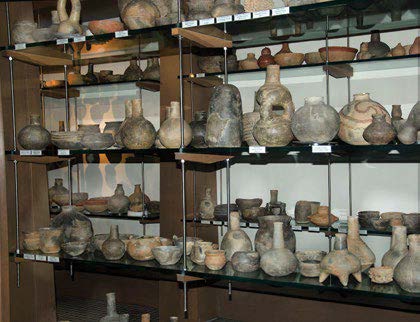
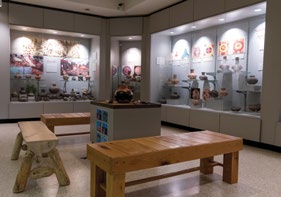
Trail of Tears Park
This site on the campus of the University of Arkansas commemorates a spot on the Trail of Tears where a group of 1,100 Cherokees led by John Benge passed through the frontier village of Fayetteville on January 18, 1839. A plaque and a native stone sculpture stand near the site of the party’s encampment.
Lake Dardanelle State Park
Lake Dardanelle State Park is located along the water route of the Trail of Tears and is one of only two sites along the trail where members of all southeastern tribes (Cherokee, Chickasaw, Creek, Choctaw and Seminole) passed in their forced journey west to Indian Territory. Long before tribes moved through this area along the Trail of Tears, this area was Cherokee land beginning in the late 1700s. The Cherokees built towns and farms in this fertile river valley.
Pea Ridge National Military Park
The site of a battle on the western frontier of the Civil War, the park offers visitors a wealth of information about the Native American participation on this front of the war, including the story of Stand Watie, a Cherokee supporter of the 1835 Treaty of Echota who became a general in the Confederate army and commanded the 2nd Cherokee Mounted Rifles during the battle.
In June 1865, Watie was the last Southern general to surrender to the Federals. Also in the park is Elkhorn Tavern, a stop along the Trail of Tears; the Cherokees camped nearby, and soldiers escorting them likely stayed in the tavern. A historical marker explains the significance of the site for those who suffered on the trail. “This is an amazing place,” said John McLarty, president of the Arkansas chapter of the Trail of Tears Association. “When you stand at the Elkhorn Tavern, you are literally on the Trail of Tears.”
Fort Smith National Historic Site
This site, devoted to a raucous frontier history – the original fort was founded to keep peace between warring tribes, and a later one became the province of Judge Isaac Parker – includes a walk to the Trail of Tears Overlook, where interpretive panels tell the story of the five tribes who were removed to Indian Territory. That viewpoint looks out on the confluence of the Arkansas and Poteau rivers, and a path marker indicates the border between Arkansas and Indian Territory.
Cob Cave
Located on the Lost Valley Trail (2.3 miles round trip), one of the Buffalo National River’s most popular trails, Cob Cave is a bluff shelter believed to have been inhabited seasonally by Native Americans between AD 1100 and 1400. When the cave was explored officially in the 1930s, archeologists from the University of Arkansas found pictographs and petroglyphs, woven bags and cultivated plants. The trailhead can be found about a half a mile off Arkansas Route 43, 1.5 miles south of Ponca.
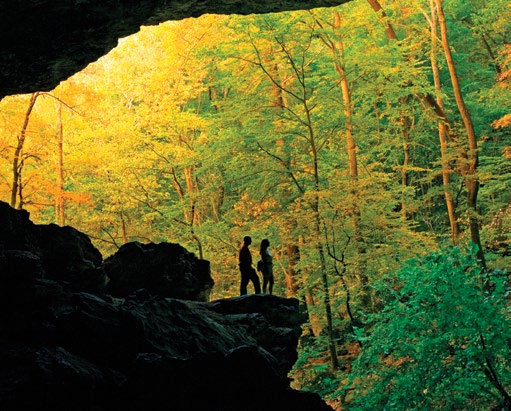
Indian Rock Cave and Trail
This 100-foot-wide, 90-foot-deep and 90-foot-high formation, carved by springs for centuries out of the sandstone cliff, contains petroglyphic evidence of Native American presence generations ago. A three-quarter-mile trail behind the Old Log Cabin accessible from the parking lot of the Indian Hills Country Club leads to the site.
Indian Rockhouse Cave on the Buffalo National River
Indian Rockhouse Trail (3.5 miles round trip, rated moderate to strenuous) leads to its namesake, one of the largest bluff shelters in the Ozarks, which was used by Native Americans some 4,000 years ago. This trail is located at Buffalo Point, 14 miles south of
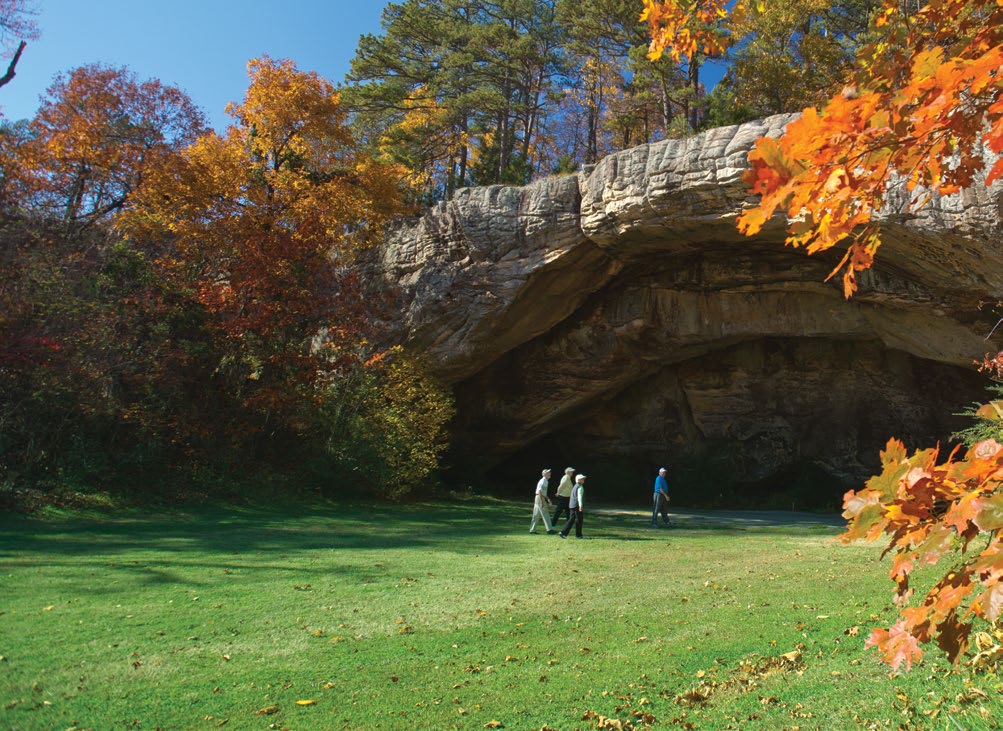
Museum of Regional History
Housed in the town’s oldest brick building, Texarkana’s Museum of Regional History has a newly renovated and reworked gallery devoted to its large collection of Caddoan pottery and artifacts. The Caddo confederation resided in part at the bend of the Red River nearby.
Caddo Indian Memorial Trail and River Walk
Twenty-one interpretive panels on a one-quarter-mile trail describe the history of the Caddo people and this historic burial ground, along with a wildflower garden. Excavations by the Arkansas Archeological Survey discovered Caddoan artifacts, including tools and weapon points, and the Caddo tribe conducted a religious ceremony there in 1989 to honor the dead buried in this place.



